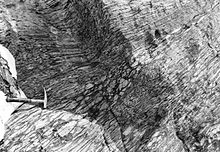Mylonite

Mylonite (from Gr. Μύλη mýle, mill ') is a metamorphic rock that was formed through the process of dislocation metamorphosis . The term was introduced by Charles Lapworth in 1885 and adopted into German specialist literature in 1910. The term mylonite describes a type of rock with a certain structure , it gives no information about the mineral composition .
Emergence
Mylonites are formed in tectonic fault zones by the shearing movement of two rock bodies sliding past each other. The main characteristic of mylonites is the ductile deformation of the rock at high temperatures. The vast majority of the minerals in a mylonite must have been changed by plastic deformation . In contrast, the minerals in a cataclasite were broken by mechanical friction, as the process took place in the brittle area . Mylonites have a distinctive layer texture and mostly a clear stretching linear that shows the direction of the tectonic movement.
Dynamic crystallization
The plastic deformation is caused by the dynamic crystallization of the minerals. The adaptation of the minerals to the prevailing shear stress takes place continuously (dynamically), above all by offsetting at the boundary surfaces of crystals , by offsetting on internal crystal lattice levels and by forming twins . If two crystals of the same type of mineral are adjacent to one another, one grain can also "consume" the other through diffusion ; this process is known as grain boundary migration.
Conditions for mylonite formation
The formation of mylonite depends on the one hand on the material properties of the parent rock and on the other hand on the physical conditions during the deformation. In typical silicate rocks of the earth's crust , which contain large amounts of quartz and feldspar , plastic deformation begins at around 280 ° C and 10 km depth. In the case of salt rocks and marble , the temperatures are significantly lower. The deformation rates are between 10 −13 and 10 −15 s −1 . The deformed minerals are usually smaller than in the parent rock. At very high temperatures and low deformation rates, however, the minerals tend to grow and coarse-grained mylonites ( blastomylonites ) are formed.
classification

Mylonites are divided into protomylonite , orthomylonite and ultramylonite according to the ratio of deformed minerals to unchanged components of the parent rock ( porphyroclasts ) . In addition, the name of the parent rock ( granite- protomylonite) or the most common mineral ( quartz- orthomylonite) is prefixed in order to name a rock more precisely.
- Protomylonite
Porphyroclasts, i.e. fragments of the original rock, have a volume share of more than 50% of the total rock as flat elements in a fine-grained environment that appears streaky. Overall, the rock has a lens-like parallel texture.
- Orthomylonite
In the rock, fine-grained components (less than 0.5 mm in diameter) predominate, which are arranged in a clear parallel texture. Porphyroclasts form 50 - 10% of the rock and are surrounded by the fine-grained matrix. Mylonites rich in mica are known as phyllonites .
- Ultramylonite
The entire rock consists of fine-grained components which, through their arrangement, create an extremely clear layer texture, a main characteristic of a mylonite. Porphyroclasts are hardly or not present, their share is less than 10%.
literature
- P. Heitzmann: Kakirite, Kataklasite, Mylonite - On the nomenclature of metamorphic rocks with deformation structures . In: Eclogae geologica Helvetiae . tape 78 , 1985, pp. 273-286 .
- CW Passchier & RAJ Trouw: Microtectonics . 2nd Edition. Springer, 2005, ISBN 978-3-540-64003-5 , pp. 118-125 .
Web links
Individual evidence
- ↑ Hans Murawski: Geological Dictionary . 8th edition. Ferd. Enke Verlag, Stuttgart 1983, ISBN 978-3-432-84108-3 , p. 151 .
- ↑ H. v. Seidlitz: About granite mylonites and their tectonic significance. Geologische Rundschau, Vol. 1, No. 5, pp. 188-197, 1910.
